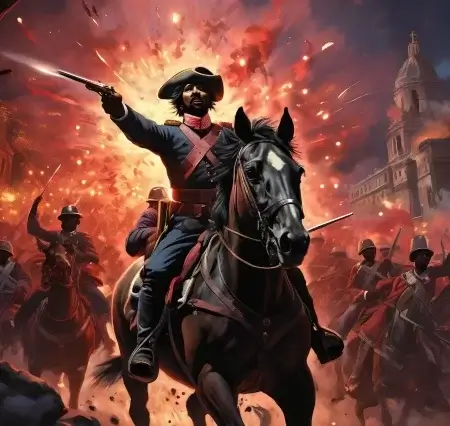In the annals of history, amidst tales of struggle and defiance leading up to the ‘Battle of Pueblo’ and ‘Cinco de Mayo’, emerges the remarkable saga of Gaspar Yanga, a former African slave who defied the odds to become a liberator. His story intertwines with the harrowing legacy of the African slave trade.
Millions of enslaved Africans ended up in South America and the Caribbean. Brazil alone got a whopping 4 million! Here’s the kicker: Mexico, yes, Mexico, had its share of about 200,000 enslaved Africans between the 1520s and 1829 🧐.
But beyond oppression, there’s a lesser-known chapter in Mexican history: the courageous African and mixed-heritage fighters who stood tall in the ‘Battle of Puebla’, etching their mark on the tapestry of time.
Cinco de Mayo: More Than Margaritas
Ever wondered what’s the deal with Cinco de Mayo? Is it just an excuse for a fiesta, or is there more to it? Well, hold on to your sombreros, because we’re about to dive into the authentic story.
The Battle of Puebla: A Legendary Showdown
So, rewind to 1861 in Mexico – Benito Juárez is at the helm, trying to steer the country out of financial turmoil. But here come France, Britain, and Spain, knocking at the door, demanding some serious cash. But Juárez isn’t about to hand over the keys to the treasury without a fight.
France’s Grand Plan and Mexico’s Surprise Response
France, led by Napoleon III, has its sights set on Mexico. They figure it’ll be a walk in the park to conquer. But wait, who’s that standing in their way? It’s General Ignacio Zaragoza and his band of soldiers – a mix of African 😲 and indigenous Mexicans ready to give the French a run for their money.
A Battle of Epic Proportions
Dawn breaks, and the Battle of Puebla kicks off. The French come in guns blazing, but Mexico’s band of fighters aren’t backing down.
You’ve got 2,000 Africans, mix heritage Africans and indigenous Mexican soldiers, staring down the barrel of a French army three times their size. Talk about David versus Goliath vibes! It’s a scene straight out of an epic saga, with the fate of a nation hanging in the balance ⚔️.
Feel the tension in the air as General Ignacio Zaragoza rallies his troops, the taste of anticipation lingering on their tongues as they prepare to make history. And then, in a flurry of action, witness the unthinkable:
For a full day, on May 5, 1862, it’s like a scene from a Hollywood blockbuster – cannons roaring, swords clashing, and the smell of gunpowder hanging heavy in the air of Puebla.
And guess what? Against all odds, those gutsy Afro and Mexican fighters don’t just hold their ground – they hand France a serious beat-down. The Aftermath: Victory for the Underdogs💪🏾!
When the dust settles, it’s a sight to behold. The French are licking their wounds, with nearly 500 soldiers out of commission. Meanwhile, General Ignacio Zaragoza troops? Well, they’ve barely broken a sweat, with fewer than 100 casualties.
Cinco de Mayo: Celebrating Heritage
Now, while Cinco de Mayo’s a big deal in Puebla, the rest of Mexico? Not so much. It’s just another day on the calendar. But across the border in the U.S., it’s a whole different story.
Cinco de Mayo Beyond Borders
Let’s zoom back to the Civil Rights Movement of 1960s and 70s.
Inspired by African-American resilience against systemic injustice in America, 1Chicano activists saw an opportunity to make their voices heard too.
Like those fighting for African-American rights, Chicano activists stood up for their community. They shared their challenges and celebrated their Mexican heritage with pride.💯
The Chicano’s saw the ‘Battle of Puebla’ as a symbol of resistance to oppression. They looked back at history and saw a connection between their fight for equality and Mexico’s win over the French. It was like saying, “If they can do it, so can we!” Cinco de Mayo became a beacon of hope for, “Hey, we’re here, and we’re proud of who we are!”

Not Just Another Holiday
Cinco de Mayo isn’t Mexican Independence Day – that’s a whole other shindig in September. Cinco de Mayo isn’t just about celebrating a military victory. In a nutshell, Cinco de Mayo is about an event that took place in Mexico in 1862.
When, on the 5th of May, a ragtag army of 2,000 soldiers, a mix of African and indigenous Mexican fighters, led by a general who was born in Texas, defeated the most powerful army in the world in the small town of Puebla✊🏾.
*How do you think showing diverse representation in historical narratives, like the Battle of Puebla, shakes up our view of the past? Does it add some spice? Comment down below⤵️
Sources: Image Credit: SFGATE 2015
El Perico Cinco de Mayo for Chicanos
1 Chicano was originally a classist and racist slur used toward low-income Mexicans that was reclaimed in the 1940s among youth who belonged to the Pachuco and Pachuca subculture. In the 1960s, Chicano was widely reclaimed in the building of a movement toward political empowerment, ethnic solidarity, and pride in being of indigenous descent.

